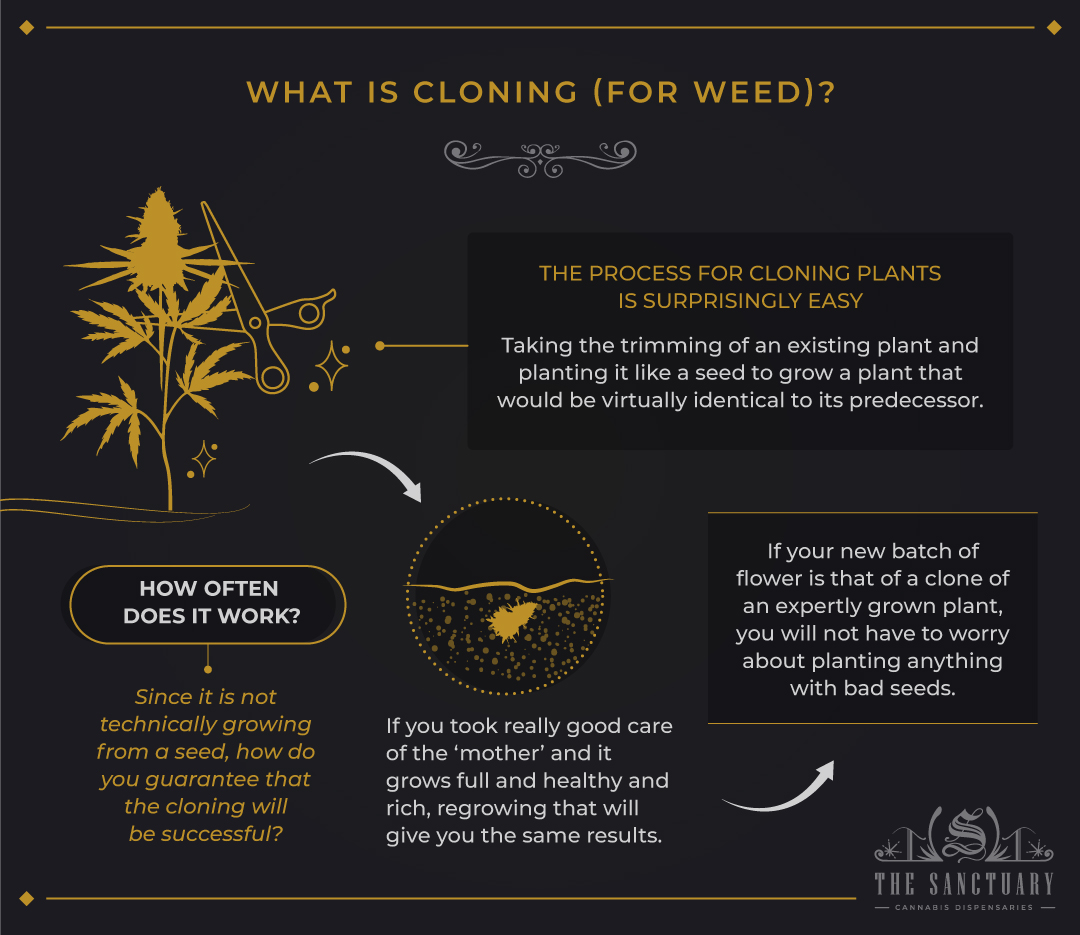Iftikhar Alam
Author
Reviewed by Cannabis Experts
Published on: August 5, 2022 | Updated on: September 11, 2024
Marijuana plants are not only a gift to canna enthusiasts (literally), but are very accessible to grow and harvest, which can be an enjoyable hobby once you learn the ropes. The only real downside to growing your own weed is when the supply runs low, whether that be in flower or seeds. But all is not lost: When you are down to the last few branches, you do not need a whole new pack of seeds. You just need clippers, growth hormones and to plant one of the branches.
If you have never tried cloning your marijuana plants and want to learn how to do it in the easiest way possible, you have come to the right place.
What is Cloning (for Weed)?
 If you are a fan of sci-fi, you might have gotten excited at ‘cloning’ and thought of all the things you would do with it. Sadly, we aren’t quite there yet for humans and most animals, but the process for cloning plants is surprisingly easy: Taking the trimming of an existing plant and planting it like a seed to grow a plant that would be virtually identical to its predecessor.
If you are a fan of sci-fi, you might have gotten excited at ‘cloning’ and thought of all the things you would do with it. Sadly, we aren’t quite there yet for humans and most animals, but the process for cloning plants is surprisingly easy: Taking the trimming of an existing plant and planting it like a seed to grow a plant that would be virtually identical to its predecessor.
Now, this only makes botanical sense because of a plant’s biology that allows it to grow new offspring literally from its own clippings. This is not an efficient way of cloning for anything but plants because you cannot ‘grow’ other living creatures and trying to clone them this same way would just be gruesome and disastrous. So just wait another 100 years before scientists make cloning chambers.
How Often Does it Work?
Now knowing what cloning (plants) is, you might be wondering how often it actually works. Since it is not technically growing from a seed, how do you guarantee that the cloning will be successful? The answer is all in the mother, or the original plant: If you took really good care of the ‘mother’ and it grows full and healthy and rich, regrowing that will give you the same results.
You can absolutely grow plants from the ground up (sorry) every single time and have great results almost every single time, but a very rare but unfortunate bad batch of seeds will pull the plug on the whole operation. However, if your new batch of flower is that of a clone of an expertly grown plant, you will not have to worry about planting anything with bad seeds.
How to Clone Your Marijuana Plants
You can check out some of our previous articles on how to grow a marijuana plant completely from seeds, which is essential to cultivation and harvesting but ends up being more time consuming than cloning your existing plants. The process is arguably the easiest method of producing quality marijuana plants and we have simplified the process into just a few steps.
Step 1: Find (or Grow) The Mother
A philosophical question like, ‘Which came first, the bud or the plant?’ would be great to ask your friends in the middle of a smoke session. The answer is the plant because (where else would the bud come from? For all intents and purposes, it is also the universal starting point for cloning your weed plants.
Should you only be growing one plant a time like some states don’t allow to exceed this, then you no longer have to wait for months to start seeing your plants bud: In the time that you spent germinating and preparing for the harvest, your plant’s clones will grow and be ready to use within a fraction of that time.
Step 2: Growth Hormones
Now that you have found the sturdiest and healthiest plant to be the ‘mother’, you should obviously have a rough idea of what your plant is going to be like. For instance, if the mother does not have a whole lot of buds but is otherwise healthy enough to be cloned, you could absolutely consider adding root hormones, PGRs or other natural growth hormones to try to boost bud production or bud quality.
Step 3: Cut and Plant the ‘Baby’
As bad as that sounds out of context, it’s what you have to do: The chosen branch(es) will have to be cut from the original plant and placed into its own separate flowering spot. Those same trimmers that you would use during the harvest time will come in handy when strategically cutting the branch to be planted and eventually grown.
Step 4: Let it Grow
Speaking of growing, that is the final step of the cloning process and it is probably the easiest. Not just because you repeat what you have been doing with the mother in terms of water and lighting, but because you only have to do this for about 7-10 days before the clone is fully grown. No seed germination or waiting for sprouting is required because your ‘baby’ has already gone through all those steps and is technically just expanding from there.
If you couldn’t already tell, it is hard for growing to get any easier and does not get any faster than that of cloning your marijuana plants.
Why Clone Instead of Growing?
It might not be the large-scale cultivator’s go-to choice for producing a field of plants at one time, but it is the go-to option when seeds are in short supply. Not to mention, you do not have to wait for seeds to germinate when cloning, so the process is cut down to only the actual growing time.
Eventually, you will need to keep planting seeds if you do want several plants at once and being able to grow tap roots (more bud per plant), but cloning will still give you a super fast copy of your magnum opus without losing any quality.
What Plants or Strains Should I Not Clone?
Now that we have covered how to successfully clone your weed plants, you might be wondering if this works for every single strain, and it essentially does. To explain, it is such an efficient and direct way of not only growing but reproducing plants from the same stem that every strain varies extremely minimally across clones.
Again, every plant has its own genetic code and that is literally just copied and grown from the trimmings, so not much is going to be lost along the way.
Sources
Footnotes
- Lawrence Jr RH. In vitro plant cloning systems. Environmental and experimental botany. 1981;21(3-4):289-300.
- Perrone C, Kline P, DuBois J. Cloning Successive Generations of Industrial Hemp (Cannabis sativa) to Assess Cannabinoid Profiles. Agricultural Sciences. 2022;13(12):1291-308.
- Wang R, He LS, Xia B, Tong JF, Li N, Peng F. A micropropagation system for cloning of hemp (Cannabis sativa L.) by shoot tip culture. Pak. J. Bot. 2009;41(2):603-8.
References
- How to Clone Cannabis. wikiHow. Accessed 4/11/2024.
- How to make marijuana clones. I Love Growing Marijuana. Accessed 4/11/2024.
- Cannabis Breeding 101. Solaris Farms. Accessed 4/11/2024.
The content provided on this blog is for informational purposes only and does not constitute medical, legal, or professional advice. Cannabis use is subject to local laws and regulations, which vary widely by jurisdiction. Always consult with a healthcare professional before starting any new treatment or altering an existing treatment regimen. The authors and publishers of this blog are not responsible for any actions taken based on the information provided herein. Use cannabis responsibly and in accordance with applicable laws. This blog is intended for adults aged 21 and over. The Sanctuary Dispensaries D186, D187.








